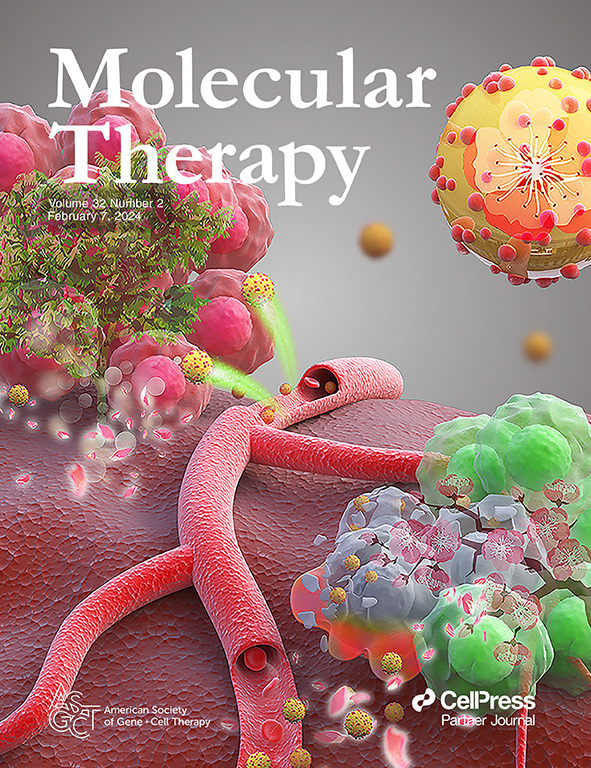TAT-PBX1融合蛋白通过AMPK-TFAM信号激活减轻lps诱导的急性肺损伤。
IF 12
1区 医学
Q1 BIOTECHNOLOGY & APPLIED MICROBIOLOGY
引用次数: 0
摘要
急性肺损伤(ALI)是一种严重的临床挑战,其特征是不受控制的肺部炎症和组织稳态破坏,通常导致严重的呼吸功能障碍。目前的药物干预和疫苗在调节疾病进展方面显示出不理想的临床结果,突出了对创新治疗策略的迫切需要。ALI的一个关键病理生理特征包括氧化还原稳态失调和过度的肺部炎症。基于PBX1已证明的减轻活性氧(ROS)诱导的细胞损伤的能力,我们假设其治疗ALI的潜力。在A549细胞中过表达PBX1可减轻脂多糖(LPS)引起的肿瘤坏死因子α (TNF-α)、白细胞介素(IL)-1β和IL-6水平升高。为了绕过病毒转导的限制,同时实现高效的大分子传递,我们设计了一种新的TAT-PBX1融合蛋白。在体内,TAT-PBX1有效减弱lps诱导的ROS积累和炎症因子,同时保持线粒体形态。恢复ATP水平和NAD+/NADH比值,上调PGC-1α/TFAM表达,抑制cGAS-STING通路激活。在机制上,TAT-PBX1靶向ampk - γ - 2激活AMPK-TFAM信号通路,发挥抗炎和肺保护作用。这些发现确定TAT-PBX1是缓解ALI病理反应的有希望的治疗候选药物。本文章由计算机程序翻译,如有差异,请以英文原文为准。
TAT-PBX1 fusion protein alleviates LPS-induced acute lung injury via AMPK-TFAM signaling activation.
Acute lung injury (ALI) represents a critical clinical challenge characterized by uncontrolled pulmonary inflammation and disrupted tissue homeostasis, often leading to severe respiratory dysfunction. Current pharmacological interventions and vaccines have demonstrated suboptimal clinical outcomes in modulating disease progression, highlighting the urgent need for innovative therapeutic strategies. A key pathophysiological feature of ALI involves dysregulation of redox homeostasis and excessive pulmonary inflammation. Based on PBX1's demonstrated capacity to mitigate reactive oxygen species (ROS)-induced cellular damage, we hypothesized its therapeutic potential for ALI management. Overexpression of PBX1 in A549 cells can alleviate the increase in tumor necrosis factor alpha (TNF-α), interleukin (IL)-1β, and IL-6 levels caused by lipopolysaccharide (LPS). To circumvent the limitations associated with viral transduction while enabling efficient macromolecular delivery, we engineered a novel TAT-PBX1 fusion protein. In vivo, TAT-PBX1 effectively attenuated LPS-induced ROS accumulation and inflammatory cytokines, while preserving mitochondrial morphology. It restored ATP levels and NAD+/NADH ratio, upregulated PGC-1α/TFAM expression, and suppressed cGAS-STING pathway activation. Mechanistically, TAT-PBX1 targets AMPKγ2 to activate the AMPK-TFAM signaling pathway, exerting anti-inflammatory and lung-protective effects. These findings identify TAT-PBX1 as a promising therapeutic candidate for mitigating pathological responses in ALI.
求助全文
通过发布文献求助,成功后即可免费获取论文全文。
去求助
来源期刊

Molecular Therapy
医学-生物工程与应用微生物
CiteScore
19.20
自引率
3.20%
发文量
357
审稿时长
3 months
期刊介绍:
Molecular Therapy is the leading journal for research in gene transfer, vector development, stem cell manipulation, and therapeutic interventions. It covers a broad spectrum of topics including genetic and acquired disease correction, vaccine development, pre-clinical validation, safety/efficacy studies, and clinical trials. With a focus on advancing genetics, medicine, and biotechnology, Molecular Therapy publishes peer-reviewed research, reviews, and commentaries to showcase the latest advancements in the field. With an impressive impact factor of 12.4 in 2022, it continues to attract top-tier contributions.
 求助内容:
求助内容: 应助结果提醒方式:
应助结果提醒方式:


